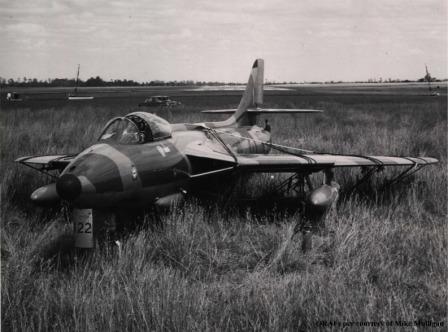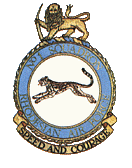By Mike Mulligan
The first use of the barrier at Thornhill was on the 22nd February 1968. Don Northcroft and John Bennie (both the late), myself
and one other (I can't remember my no.2) were tasked to do different timed low level 'nav ex's' as pairs and then meet up at
Beatrice ( south of Salisbury ) and return as a battle formation four aircraft to Thornhill, which was successfully accomplished.
We then approached for a battle break from the north for runway 13. Don was the lead a/c with me at no. 3 ; I think the air traffic
controller was Bill Caldwell!! On downwind I kept on having to increase my power to maintain the normal downwind speed, which seemed
rather odd as the power setting R.P.M. seemed far too high for the required speed. Only on the final approach when we were all
cleared to land did I see just how close I was getting to the no. 2 (John Bennie).
However everything then was happening so quickly. I touched down and skipped along the ground quite merrily. At this stage I was
committed to the landing and could not overshoot. I streamed the breaking parachute and I felt a fraction of a deceleration before
it tore and streamed behind giving no help at all. At this stage I told both a/c ahead of me to stay on their respective sides of
the runway, as I was approaching them with plenty of overtake.
I passed the no. 2 and weaved through the gap to the other side of the runway and then overtook the lead a/c. I called 'PRACTICE
BARRIER BARRIER BARRIER ',which was often done to practise A.T.C.'s reactions, and then I said 'No I mean BARRIER BARRIER BARRIER'
Immediately the arrester barrier went up and shortly thereafter I engaged it. As you can see from the photo the overshoot area's
grass had not even been cut, as the barrier had not been used before.

Coincidentally from the formation break to the touch downs all had been observed from outside the Flying Wing offices' by O.C.F.W.
himself, the then Wg. Cdr. Chris Dams.
There was minimal damage to Hunter 122, but where the cables had arrested the a/c at the air intake, took a good length of time to
repair to once again receive laminar air flow into the engine intake. The rubber grommet at the pitot tube had lifted away resulting
in a reduced airflow ( pressure ) to the air speed indicator (A.S.I.) resulting in a considerable under-reading. I probably
landed +- 40 kts. too high. So in retrospect I could have done an overshoot and then done a formation landing, but my fuel shortage,
the time to get another a/c into the air etc. was too much and my commitment to landing had already been made.
Hunter 122 came to a stop 135 yds. into the grass, which was definitely better than being on the White Waters dam road!! It was an
interesting day with the vision of that memory still very clear in my mind to this day.
Thanks to Mike Mulligan and ORAFs for this article



